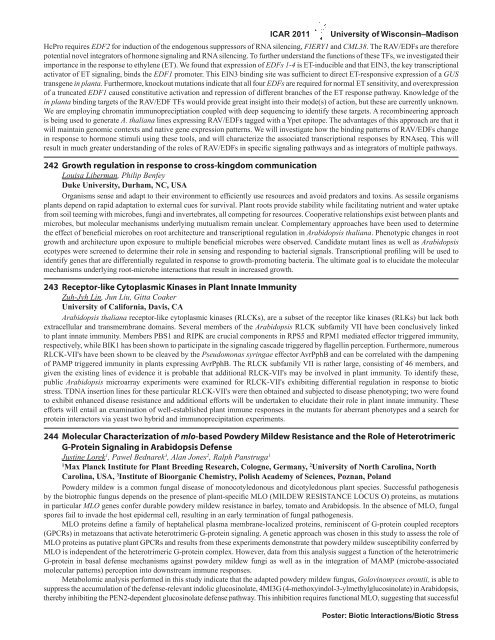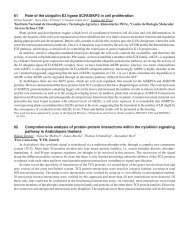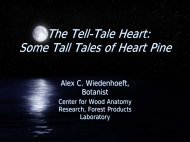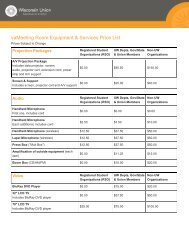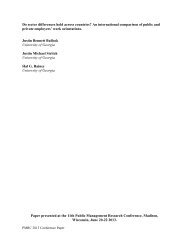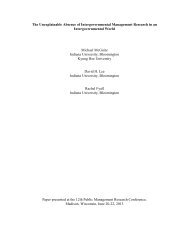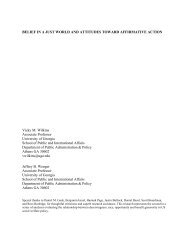Full Abstract Book - Wisconsin Union - University of Wisconsin ...
Full Abstract Book - Wisconsin Union - University of Wisconsin ...
Full Abstract Book - Wisconsin Union - University of Wisconsin ...
You also want an ePaper? Increase the reach of your titles
YUMPU automatically turns print PDFs into web optimized ePapers that Google loves.
ICAR 2011<br />
<strong>University</strong> <strong>of</strong> <strong>Wisconsin</strong>–Madison<br />
HcPro requires EDF2 for induction <strong>of</strong> the endogenous suppressors <strong>of</strong> RNA silencing, FIERY1 and CML38. The RAV/EDFs are therefore<br />
potential novel integrators <strong>of</strong> hormone signaling and RNA silencing. To further understand the functions <strong>of</strong> these TFs, we investigated their<br />
importance in the response to ethylene (ET). We found that expression <strong>of</strong> EDFs 1-4 is ET-inducible and that EIN3, the key transcriptional<br />
activator <strong>of</strong> ET signaling, binds the EDF1 promoter. This EIN3 binding site was sufficient to direct ET-responsive expression <strong>of</strong> a GUS<br />
transgene in planta. Furthermore, knockout mutations indicate that all four EDFs are required for normal ET sensitivity, and overexpression<br />
<strong>of</strong> a truncated EDF1 caused constitutive activation and repression <strong>of</strong> different branches <strong>of</strong> the ET response pathway. Knowledge <strong>of</strong> the<br />
in planta binding targets <strong>of</strong> the RAV/EDF TFs would provide great insight into their mode(s) <strong>of</strong> action, but these are currently unknown.<br />
We are employing chromatin immunopreciptiation coupled with deep sequencing to identify these targets. A recombineering approach<br />
is being used to generate A. thaliana lines expressing RAV/EDFs tagged with a Ypet epitope. The advantages <strong>of</strong> this approach are that it<br />
will maintain genomic contexts and native gene expression patterns. We will investigate how the binding patterns <strong>of</strong> RAV/EDFs change<br />
in response to hormone stimuli using these tools, and will characterize the associated transcriptional responses by RNAseq. This will<br />
result in much greater understanding <strong>of</strong> the roles <strong>of</strong> RAV/EDFs in specific signaling pathways and as integrators <strong>of</strong> multiple pathways.<br />
242 Growth regulation in response to cross-kingdom communication<br />
Louisa Liberman, Philip Benfey<br />
Duke <strong>University</strong>, Durham, NC, USA<br />
Organisms sense and adapt to their environment to efficiently use resources and avoid predators and toxins. As sessile organisms<br />
plants depend on rapid adaptation to external cues for survival. Plant roots provide stability while facilitating nutrient and water uptake<br />
from soil teeming with microbes, fungi and invertebrates, all competing for resources. Cooperative relationships exist between plants and<br />
microbes, but molecular mechanisms underlying mutualism remain unclear. Complementary approaches have been used to determine<br />
the effect <strong>of</strong> beneficial microbes on root architecture and transcriptional regulation in Arabidopsis thaliana. Phenotypic changes in root<br />
growth and architecture upon exposure to multiple beneficial microbes were observed. Candidate mutant lines as well as Arabidopsis<br />
ecotypes were screened to determine their role in sensing and responding to bacterial signals. Transcriptional pr<strong>of</strong>iling will be used to<br />
identify genes that are differentially regulated in response to growth-promoting bacteria. The ultimate goal is to elucidate the molecular<br />
mechanisms underlying root-microbe interactions that result in increased growth.<br />
243 Receptor-like Cytoplasmic Kinases in Plant Innate Immunity<br />
Zuh-Jyh Lin, Jun Liu, Gitta Coaker<br />
<strong>University</strong> <strong>of</strong> California, Davis, CA<br />
Arabidopsis thaliana receptor-like cytoplasmic kinases (RLCKs), are a subset <strong>of</strong> the receptor like kinases (RLKs) but lack both<br />
extracellular and transmembrane domains. Several members <strong>of</strong> the Arabidopsis RLCK subfamily VII have been conclusively linked<br />
to plant innate immunity. Members PBS1 and RIPK are crucial components in RPS5 and RPM1 mediated effector triggered immunity,<br />
respectively, while BIK1 has been shown to participate in the signaling cascade triggered by flagellin perception. Furthermore, numerous<br />
RLCK-VII's have been shown to be cleaved by the Pseudomonas syringae effector AvrPphB and can be correlated with the dampening<br />
<strong>of</strong> PAMP triggered immunity in plants expressing AvrPphB. The RLCK subfamily VII is rather large, consisting <strong>of</strong> 46 members, and<br />
given the existing lines <strong>of</strong> evidence it is probable that additional RLCK-VII's may be involved in plant immunity. To identify these,<br />
public Arabidopsis microarray experiments were examined for RLCK-VII's exhibiting differential regulation in response to biotic<br />
stress. TDNA insertion lines for these particular RLCK-VII's were then obtained and subjected to disease phenotyping; two were found<br />
to exhibit enhanced disease resistance and additional efforts will be undertaken to elucidate their role in plant innate immunity. These<br />
efforts will entail an examination <strong>of</strong> well-established plant immune responses in the mutants for aberrant phenotypes and a search for<br />
protein interactors via yeast two hybrid and immunoprecipitation experiments.<br />
244 Molecular Characterization <strong>of</strong> mlo-based Powdery Mildew Resistance and the Role <strong>of</strong> Heterotrimeric<br />
G-Protein Signaling in Arabidopsis Defense<br />
Justine Lorek 1 , Pawel Bednarek 3 , Alan Jones 2 , Ralph Panstruga 1<br />
1<br />
Max Planck Institute for Plant Breeding Research, Cologne, Germany, 2 <strong>University</strong> <strong>of</strong> North Carolina, North<br />
Carolina, USA, 3 Institute <strong>of</strong> Bioorganic Chemistry, Polish Academy <strong>of</strong> Sciences, Poznan, Poland<br />
Powdery mildew is a common fungal disease <strong>of</strong> monocotyledonous and dicotyledonous plant species. Successful pathogenesis<br />
by the biotrophic fungus depends on the presence <strong>of</strong> plant-specific MLO (MILDEW RESISTANCE LOCUS O) proteins, as mutations<br />
in particular MLO genes confer durable powdery mildew resistance in barley, tomato and Arabidopsis. In the absence <strong>of</strong> MLO, fungal<br />
spores fail to invade the host epidermal cell, resulting in an early termination <strong>of</strong> fungal pathogenesis.<br />
MLO proteins define a family <strong>of</strong> heptahelical plasma membrane-localized proteins, reminiscent <strong>of</strong> G-protein coupled receptors<br />
(GPCRs) in metazoans that activate heterotrimeric G-protein signaling. A genetic approach was chosen in this study to assess the role <strong>of</strong><br />
MLO proteins as putative plant GPCRs and results from these experiments demonstrate that powdery mildew susceptibility conferred by<br />
MLO is independent <strong>of</strong> the heterotrimeric G-protein complex. However, data from this analysis suggest a function <strong>of</strong> the heterotrimeric<br />
G-protein in basal defense mechanisms against powdery mildew fungi as well as in the integration <strong>of</strong> MAMP (microbe-associated<br />
molecular patterns) perception into downstream immune responses.<br />
Metabolomic analysis performed in this study indicate that the adapted powdery mildew fungus, Golovinomyces orontii, is able to<br />
suppress the accumulation <strong>of</strong> the defense-relevant indolic glucosinolate, 4MI3G (4-methoxyindol-3-ylmethylglucosinolate) in Arabidopsis,<br />
thereby inhibiting the PEN2-dependent glucosinolate defense pathway. This inhibition requires functional MLO, suggesting that successful<br />
Poster: Biotic Interactions/Biotic Stress


